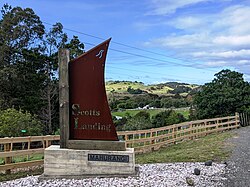Scotts Landing
Scotts Landing | |
|---|---|
 Scotts Landing sign | |
 | |
| Coordinates: 36°29′06″S 174°43′30″E / 36.485°S 174.725°ECoordinates: 36°29′06″S 174°43′30″E / 36.485°S 174.725°E | |
| Country | New Zealand |
| Region | Auckland Region |
| Ward | Rodney ward |
| Local board | Rodney Local Board |
| Government | |
| • Territorial Authority | Auckland Council |
| Area | |
| • Total | 2.56 km2 (0.99 sq mi) |
| Population (2018 census)[2] | |
| • Total | 177 |
| • Density | 69/km2 (180/sq mi) |
Scotts Landing, also called Mahurangi East, is a rural settlement in the Auckland Region of New Zealand. It is at the end of a narrow peninsula on the eastern side of Mahurangi Harbour. Algies Bay is to the north.[3]
Mahurangi Regional Park at Scott Point[4] (often called Scotts Landing) has a historic building, the Scott Homestead built in 1877.[5][6] A causeway between Scotts Landing and Casnell Island (Motu Maunganui) is accessible.at low tide. The island was a pā site in the 16th century.[7]
Burton Wells Scenic Reserve is a park named after a local surveyor.[8]
Mahurangi Heads School operated from 1869.[9] It closed in the 1920s or 1930s, but the school building was still standing about 1941.[8]
Demographics
Statistics New Zealand describes Scotts Landing-Mahurangi East as a rural settlement, which covers 2.56 km2 (0.99 sq mi).[1] Scotts Landing-Mahurangi East is part of the larger Algies Bay-Scotts Landing statistical area.[10]
| Year | Pop. | ±% p.a. |
|---|---|---|
| 2006 | 165 | — |
| 2013 | 195 | +2.42% |
| 2018 | 177 | −1.92% |
| Source: [2] | ||
Scotts Landing-Mahurangi East had a population of 177 at the 2018 New Zealand census, a decrease of 18 people (−9.2%) since the 2013 census, and an increase of 12 people (7.3%) since the 2006 census. There were 87 households, comprising 90 males and 87 females, giving a sex ratio of 1.03 males per female, with 12 people (6.8%) aged under 15 years, 12 (6.8%) aged 15 to 29, 69 (39.0%) aged 30 to 64, and 84 (47.5%) aged 65 or older.
Ethnicities were 100.0% European/Pākehā, 6.8% Māori, and 1.7% other ethnicities. People may identify with more than one ethnicity.
Although some people chose not to answer the census's question about religious affiliation, 55.9% had no religion, 30.5% were Christian and 3.4% were Buddhist.
Of those at least 15 years old, 60 (36.4%) people had a bachelor's or higher degree, and 15 (9.1%) people had no formal qualifications. 39 people (23.6%) earned over $70,000 compared to 17.2% nationally. The employment status of those at least 15 was that 42 (25.5%) people were employed full-time, 36 (21.8%) were part-time, and 3 (1.8%) were unemployed.[2]
Notes
- ^ a b "ArcGIS Web Application". statsnz.maps.arcgis.com. Retrieved 26 May 2022.
- ^ a b c "Statistical area 1 dataset for 2018 Census". Statistics New Zealand. March 2020. 7001341 and 7001350.
- ^ Harriss, Gavin (March 2022). "NZ Topo Map" (Map). Burton Wells Reserve, Auckland.
- ^ "Scott Point, Mahurangi Regional Park (East)". Auckland Council. Retrieved 25 May 2020.
- ^ "New Mahurangi parkland provides unrivalled access to harbour". Our Auckland. Auckland Council. 20 February 2020.
- ^ "Mahurangi Regional Park" (PDF). Auckland City Council. Retrieved 30 May 2022.
- ^ "Casnell Island". Mahurangi East Residents & Ratepayers Association. 3 June 2019.
- ^ a b "Burton Wells". Mahurangi East Residents & Ratepayers Association. Retrieved 26 May 2022.
- ^ "Northland Schools in the Year 1870". Northern Advocate. 30 May 1935.
- ^ 2018 Census place summary: Algies Bay-Scotts Landing
- Use New Zealand English from May 2022
- All Wikipedia articles written in New Zealand English
- Use dmy dates from May 2022
- Articles with short description
- Short description with empty Wikidata description
- Infobox mapframe without OSM relation ID on Wikidata
- Coordinates not on Wikidata
- Matakana Coast
- Rodney District
- Populated places in the Auckland Region
- Pages using the Kartographer extension
